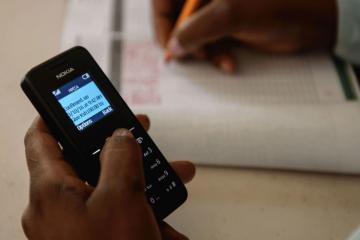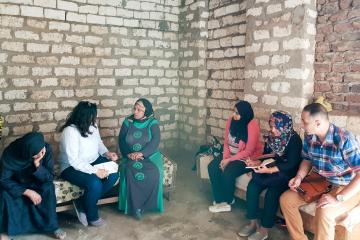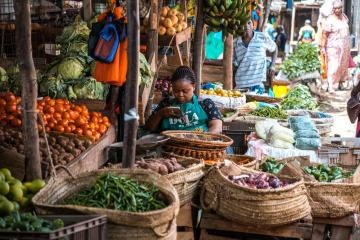
Saving for the future: Facilitating success for a common resolution

At the start of a new year, many people around the world set resolutions to improve their lives over the course of the year: to eat healthier food, to be kinder, and to quit smoking, to name just a few. Many resolutions are bound to fade over time—one common statistic claims that only 8 percent of Americans actually achieve the resolutions they set at the beginning of the year. But evidence from a wide body of research provides us with insights that can help us achieve our goals.
One relatively well-researched area, for example, is helping people save for the future. Savings represent a pool of funds that can be used to invest in promising opportunities or to cope with unexpected setbacks. Yet, in 2017, 52 percent of adults worldwide reported that they had not saved or set aside any money in the past 12 months, according to the World Bank’s 2018 Global Findex. Adults in developing countries are less likely to save than their counterparts in high-income countries; in 2017, only 43 percent of adults in developing countries reported saving any money in the past 12 months, compared to 71 percent of adults in high-income countries. Given that savings can enable people to smooth consumption and finance productive investments, what explains these low savings rates? And what can (or should) be done to increase savings behavior?
Researchers affiliated with J-PAL and our sister organization Innovations for Poverty Action (IPA) have identified five potential barriers that prevent people, especially low-income individuals, from saving:
- First, costs, both monetary and non-monetary, can impede account ownership and use. Especially in developing countries, the accounts available to low-income individuals often charge fees for opening and withdrawing funds from accounts, and many have minimum balance requirements. Households may also face non-monetary costs that prevent them from using savings accounts, like the time required to travel to the nearest bank branch. Reducing these costs can promote savings product ownership and use, and in a number of studies has also led to increases in investment, income, and resilience to setbacks. However, access to accounts does not guarantee increased savings: according to the Global Findex, only 31 percent of account owners in developing countries reported having saved at a financial institution in the past twelve months.
- Second, people’s natural behavioral tendencies can lead them to save less than they would prefer. Simple forgetfulness, over-optimism, or the tendency to prioritize today’s spending decisions over those in the future lead many to forgo saving. Financial products specifically designed to overcome behavioral biases have been effective tools to increase savings in a number of contexts. Examples include reminders to save, peer savings monitors and savings groups that leverage social pressure, and commitment savings products that restrict the use of funds until a certain goal is met.
- Third, social links and obligations affect savings behavior within and between households. Individuals often face competing interests for their money from spouses, relatives, and friends, both within and outside the household. Within the household, saving and investment decisions depend on the distribution of decision-making power and the compatibility of individuals’ preferences for spending and saving. Differences in bargaining power can affect women’s demand for products that make it easier to access cash (e.g., ATM cards); conversely, products that restrict access to cash (e.g., mobile transfers, commitment savings accounts) can increase bargaining power. Savings products can also reduce dependence on loans or transfers from a household’s social network.
- Fourth, lack of trust in financial institutions may affect the willingness of individuals to save in banks or other institutions. Similarly, regulatory barriers such as “know your customer” rules may disproportionately affect low-income individuals who may lack official identification or a residential address. These regulations can increase costs for low-income households to save in formal financial institutions. As evidence on increasing trust in financial institutions and addressing regulatory barriers is limited, this is a promising area for future research.
- Finally, knowledge gaps and limited information can lead people to under-save, over-save, or save inefficiently. Although policymakers and practitioners alike view financial literacy and capability as priority areas to increase access to finance among low-income populations, traditional classroom-based trainings have rarely succeeded in imparting lasting knowledge or changing people’s financial behavior. Recent evidence suggests that simple, targeted, actionable, and/or accessible trainings are more likely to change financial behaviors.
With this evidence at hand, a question emerges: Should we encourage people to save? Evidence from a number of randomized evaluations suggests that offering people savings products can lead to increased investment in businesses or education, increased income, reduced vulnerability to setbacks, or reduced debt. (For a more comprehensive review of savings product impact evaluations, see Figure 5 of Dupas, Karlan, and Robinson 2018.)
However, increasing savings balances may not be ideal for all people at all times. For example, it may be optimal for a household to pay down existing high-interest debt rather than save in an account that pays a modest interest rate or charges account holders to maintain or withdraw funds. In other cases, the benefits to spending income immediately—for instance, in the case of food insecurity or a health emergency—may be larger than the benefits of saving. In general, financial decisions are complicated and depend on the unique circumstances facing any individual or household.
While no recommendation can be one-size-fits-all, as a development community, we should work to ensure that every household has access to financial products and services that meet their needs, and to the information and knowledge that will enable them to use those products and services. Banks and microfinance institutions should (continue to) offer low-cost or free basic savings accounts, which make it less costly for households to save in a formal institution.
When designing savings products for low-income households, financial institutions should consider how product design can help overcome barriers to saving. Researchers should continue to study the causes and consequences of under-saving, as well as the innovations or interventions that seek to drive savings behavior. Finally, funders should continue to support the development and evaluation of new strategies to reach those who are under-served or excluded by the existing financial system.


